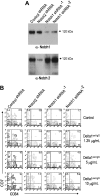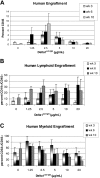Dose-dependent effects of the Notch ligand Delta1 on ex vivo differentiation and in vivo marrow repopulating ability of cord blood cells
- PMID: 15976178
- PMCID: PMC1366491
- DOI: 10.1182/blood-2005-03-1131
Dose-dependent effects of the Notch ligand Delta1 on ex vivo differentiation and in vivo marrow repopulating ability of cord blood cells
Abstract
Although significant advances have been made over the last decade with respect to our understanding of stem cell biology, progress has been limited in the development of successful techniques for clinically significant ex vivo expansion of hematopoietic stem and progenitor cells. We here describe the effect of Notch ligand density on induction of Notch signaling and subsequent cell fate of human CD34+CD38- cord blood progenitors. Lower densities of Delta1(ext-IgG) enhanced the generation of CD34+ cells as well as CD14+ and CD7+ cells, consistent with early myeloid and lymphoid differentiation, respectively. However, culture with increased amounts of Delta1(ext-IgG) induced apoptosis of CD34+ precursors resulting in decreased cell numbers, without affecting generation of CD7+ cells. RNA interference studies revealed that the promotion of lymphoid differentiation was primarily mediated by Delta1 activation of Notch1. Furthermore, enhanced generation of NOD/SCID repopulating cells was seen following culture with lower but not higher densities of ligand. These studies indicate critical, quantitative aspects of Notch signaling in affecting hematopoietic precursor cell-fate outcomes and suggest that density of Notch ligands in different organ systems may be an important determinant in regulating cell-fate outcomes. Moreover, these findings contribute to the development of methodology for manipulation of hematopoietic precursors for therapeutic purposes.
Figures





Similar articles
-
Density of the Notch ligand Delta1 determines generation of B and T cell precursors from hematopoietic stem cells.J Exp Med. 2005 May 2;201(9):1361-6. doi: 10.1084/jem.20042450. Epub 2005 Apr 25. J Exp Med. 2005. PMID: 15851488 Free PMC article.
-
Effects of Delta1 and Jagged1 on early human hematopoiesis: correlation with expression of notch signaling-related genes in CD34+ cells.Stem Cells. 2006 May;24(5):1328-37. doi: 10.1634/stemcells.2005-0207. Epub 2006 Jan 12. Stem Cells. 2006. PMID: 16410393
-
Constitutively active Notch4 promotes early human hematopoietic progenitor cell maintenance while inhibiting differentiation and causes lymphoid abnormalities in vivo.Blood. 2004 Oct 15;104(8):2315-22. doi: 10.1182/blood-2004-01-0204. Epub 2004 Jul 1. Blood. 2004. PMID: 15231576
-
Ex vivo expansion of human hematopoietic stem and progenitor cells.Blood. 2011 Jun 9;117(23):6083-90. doi: 10.1182/blood-2011-01-283606. Epub 2011 Mar 23. Blood. 2011. PMID: 21436068 Free PMC article. Review.
-
Ex vivo expansion of hematopoietic stem cells.Sci China Life Sci. 2015 Sep;58(9):839-53. doi: 10.1007/s11427-015-4895-3. Epub 2015 Aug 5. Sci China Life Sci. 2015. PMID: 26246379 Review.
Cited by
-
Characterization of the growth modulatory activities of osteoblast conditioned media on cord blood progenitor cells.Cytotechnology. 2016 Dec;68(6):2257-2269. doi: 10.1007/s10616-016-0019-6. Epub 2016 Oct 18. Cytotechnology. 2016. PMID: 27757713 Free PMC article.
-
Germline ETV6 mutations in familial thrombocytopenia and hematologic malignancy.Nat Genet. 2015 Feb;47(2):180-5. doi: 10.1038/ng.3177. Epub 2015 Jan 12. Nat Genet. 2015. PMID: 25581430 Free PMC article.
-
Recent advances in engineering hydrogels for niche biomimicking and hematopoietic stem cell culturing.Front Bioeng Biotechnol. 2022 Nov 24;10:1049965. doi: 10.3389/fbioe.2022.1049965. eCollection 2022. Front Bioeng Biotechnol. 2022. PMID: 36507253 Free PMC article. Review.
-
Ex vivo expansion of cord blood.Bone Marrow Transplant. 2009 Nov;44(10):673-81. doi: 10.1038/bmt.2009.284. Epub 2009 Oct 5. Bone Marrow Transplant. 2009. PMID: 19802023 Free PMC article. Review.
-
Challenges in umbilical cord blood stem cell banking for stem cell reviews and reports.Stem Cell Rev Rep. 2010 Mar;6(1):8-14. doi: 10.1007/s12015-009-9105-x. Stem Cell Rev Rep. 2010. PMID: 19997789 Review.
References
-
- Izon DJ, Punt JA, Pear WS. Deciphering the role of Notch signaling in lymphopoiesis. Curr Opin Immunol. 2002;14: 192-199. - PubMed
-
- Allman D, Punt JA, Izon DJ, Aster JC, Pear WS. An invitation to T and more: notch signaling in lymphopoiesis. Cell. 2002;109(suppl): S1–S11. - PubMed
-
- Robson-MacDonald H, Wilson A, Radtke F. Notch1 and T-cell development: insights from conditional knockout mice. Trends Immunol. 2001;22: 155-160. - PubMed
-
- Jones P, May G, Healy L, et al. Stromal expression of Jagged 1 promotes colony formation by fetal hematopoietic progenitor cells. Blood. 1998;92: 1505-1511. - PubMed
Publication types
MeSH terms
Substances
Grants and funding
LinkOut - more resources
Full Text Sources
Other Literature Sources
Medical
Research Materials
Miscellaneous

